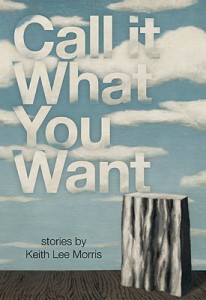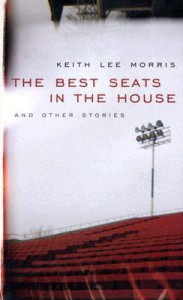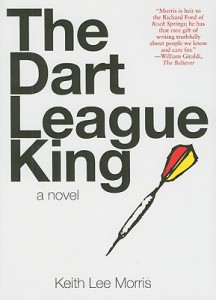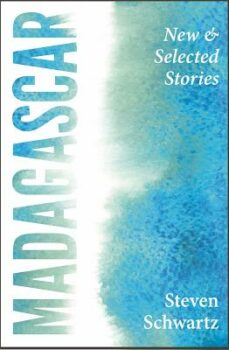 I’ve always fantasized about a reality show for literary writers. It’s exactly what we need, isn’t it? A showcase that rewards talent, that thrusts the deserving into fame, that gets the general public excited about what we do. There are reality shows for singing, dancing, comedy, cooking, filmmaking, fashion design, interior design, variety shows. Why not writing?
I’ve always fantasized about a reality show for literary writers. It’s exactly what we need, isn’t it? A showcase that rewards talent, that thrusts the deserving into fame, that gets the general public excited about what we do. There are reality shows for singing, dancing, comedy, cooking, filmmaking, fashion design, interior design, variety shows. Why not writing?
Well, there are plenty of good reasons why not, but maybe the principal one is that punching a keyboard isn’t a performance that many people want to see. Writing, as a practice, doesn’t contain much drama. Yes, Oprah scuffles with James Frey, and frauds such as JT Leroy are occasionally unmasked, and spouses throw plates when they’re tired of being neglected, but these dramas occur in the aftermath, not in the act of writing. The act itself—fingers against the keyboard, ink on the page—doesn’t involve backstabbing or bickering or public humiliation, at least not that a camera could capture. It doesn’t make people fall in or out of love. It doesn’t leave them weeping over their changed lives. That stuff happens in a narrative, not while the narrative is being constructed.
Or so it seemed until I got my hands on Keith Lee Morris’s newest collection of short fiction, Call It What You Want (Tin House Books, March 2010).
In these thirteen stories, which move from gritty realism in the first half to magical realism in the second, characters are constantly engaged in the act of narrative construction. Again and again Morris structures his stories to obscure actual events, thereby forcing the characters to remember, speculate, or fantasize them into being, much like writers do. Only these characters are not writers—they are a meth addict, a car salesman, a bartender stranded on a desert island. They are people who shouldn’t care about narrative construction as much as writers, but, for clear and compelling reasons, do. And the fallout from their narrative choices includes—yes—betrayal, humiliation, lost love, lives forever changed.
For example, in the opening story, “Testimony,” a former meth addict, now sober, testifies in court about the day one of his friends killed another. Most of the story takes place in the courtroom, where the protagonist, Robert, must mine drug-clouded memories, interpret clues, and navigate the prosecution’s insinuations to reconstruct what has happened. To complicate this, he is testifying to avoid accessory-to-murder charges, so he battles conflicting impulses to protect his friend and to incriminate his friend, to conceal embarrassing information and to seek out the truth. But facts and memories are slippery, which makes truth an elusive target and gives Robert choices about how to shape his story:
They’d told me what to say, the prosecutors, or not what to say specifically, but how to say it, like, OK, that’s good, that’s fine, Robert, just tell it like that, just tell the truth like you’d naturally tell it, or if they didn’t like how I was saying something they’d wrinkle up their faces, [. . .] and they’d say, Is it possible that you’re leaving something out? Is it possible that you might remember that in more detail? And then they’d say stuff like be confident because you’re telling the truth and speak loud and be clear and so on. But I was beginning to think that was easier said than done.
If this sounds like a conversation you’ve heard in a fiction workshop or a craft essay you’ve read about memoir, you’re getting the point. Because the story is structured around the testimony rather than the killing, it emphasizes the way Robert creates his narrative over the events themselves. The prosecutors ask him for the truth, just as long as it’s the truth that serves their purpose, which calls into question the basic nature of “truth.” They require him to supply firm, specific memories when his recollections are vague and pliable, which calls into question the reliability of memory. They tell him to be confident, speak loud, be clear, suggesting that his voice lacks authority, which will influence whether or not his audience accepts his story. All of this illustrates how shading facts can impact their trueness, an issue that obsesses many fiction writers and memoirists.
 From the language in the passage itself, full of halts and backtracking and forward rushes, we can understand what the prosecutors worry about—Robert seems to barely have his story under control. Morris intends this, of course, and he can pull it off only because he has such control over voice and character and narrative development. The final effect is that Robert recognizes how difficult it is to tell a story. We writers might be tempted to add especially for us, because Robert’s complaints feel so familiar. But the implication is the opposite: especially for those who aren’t writers. Robert isn’t worried about completing his thesis or placing his work in a good journal; he’s worried about the fate of his friend, and his own. Again, the language plays an important role: the tone is casual, conversational, lacking the concision and directness any half-competent writer would employ. Morris chooses this style to point out that Robert is no writer, and even so, there are serious stakes attached to his narrative choices—incarceration, retribution, betrayal. His friend, after all, listens to the testimony from the defendant’s table, sobbing.
From the language in the passage itself, full of halts and backtracking and forward rushes, we can understand what the prosecutors worry about—Robert seems to barely have his story under control. Morris intends this, of course, and he can pull it off only because he has such control over voice and character and narrative development. The final effect is that Robert recognizes how difficult it is to tell a story. We writers might be tempted to add especially for us, because Robert’s complaints feel so familiar. But the implication is the opposite: especially for those who aren’t writers. Robert isn’t worried about completing his thesis or placing his work in a good journal; he’s worried about the fate of his friend, and his own. Again, the language plays an important role: the tone is casual, conversational, lacking the concision and directness any half-competent writer would employ. Morris chooses this style to point out that Robert is no writer, and even so, there are serious stakes attached to his narrative choices—incarceration, retribution, betrayal. His friend, after all, listens to the testimony from the defendant’s table, sobbing.
This dynamic continues in the second story, “Camel Light,” which consists almost entirely of the speculations of the protagonist, Rick, who finds a cigarette on his kitchen floor and wonders how it got there. After much deliberation, he rules out his daughter because of her personality and his son because of his age, which leaves only his wife, who quit smoking when he did, sixteen years ago. He reflects on their present situation, then imagines a scenario, in extreme and painful detail, that would result in his wife bringing home a man who smokes. This forces him to contemplate further ramifications: their divorce, his rented apartment, a separation from his children, the other man living in his house. And he decides he will have to sleep with a coworker, grow his hair out, buy a motorcycle or sailboat, and “holy shit, he could write his novel.”
This last option is presented as preposterous—“You’d be talking bestseller. He’d have to look into finding an agent”—but it makes clear the link between his speculation and real narrative construction. Rick is making up a story just as a novelist would. Morris’s goal, however, is not simply to replicate what we go through every day at the keyboard; it’s to break the illusion that we writers have a monopoly on what we go through every day at the keyboard. It’s to answer the lament that nobody cares about narrative choices but us. Morris shows us our process of composition, our lofty visions for what we produce, and at first it feels like an inside joke, but his ultimate point is that it can’t be an inside joke because we are not insiders. People go through this process every day, and it has as big an impact on them as it does on us.
 Rick’s act of invention, for example, has profound consequences for him. The conditional tense falls away, as if he has started to consider these things not possibilities but actual events: “Now that he had been broken, none of the things he had broken himself for would be there to sustain him, and his old pre-broken self was gone, faded to a point of light he could find only in memory.” In other words, he has changed since the story’s beginning, even though everything that has happened has been imagined. The act of narrative construction—not the aftermath, not the repercussions, but the actual act of formulating a story—has permanently altered his life, and it leaves him crying at the kitchen table for what he has lost.
Rick’s act of invention, for example, has profound consequences for him. The conditional tense falls away, as if he has started to consider these things not possibilities but actual events: “Now that he had been broken, none of the things he had broken himself for would be there to sustain him, and his old pre-broken self was gone, faded to a point of light he could find only in memory.” In other words, he has changed since the story’s beginning, even though everything that has happened has been imagined. The act of narrative construction—not the aftermath, not the repercussions, but the actual act of formulating a story—has permanently altered his life, and it leaves him crying at the kitchen table for what he has lost.
Other examples abound. In “Blackout,” a married man wakes up after a high school reunion with a naked photo of his old flame and no memory of what happened. The story is about the narrative he constructs to fill that troubling gap, how he battles conflicting impulses about what to tell himself, and how his choices impact his marriage. And again Morris makes it clear that this is no writer, not only with voice but also with this sudden interjection: “Fuck me—who ever said I could tell a story? It was my wife’s idea that I get it all out.” Composing a story is as necessary for him as for any writer, and as bewildering, if not more so. But he is a car salesman. He has no goals for his story other than to coax it into existence, and it is the process alone that threatens to ruin him.
In “Desert Island Romance,” a stranded couple finds consolation by pretending themselves into their old lives. The story is about the narratives they construct about those old lives and how fantasy eventually overtakes reality, how fiction becomes fact. The man, Roger, begins to spend too much time at “work,” a bamboo stand he has designated as the bar he used to tend, and the woman, Sharon, moves “back east,” which is the other side of the island. Eventually Sharon tries to puncture Roger’s fictional world with a “letter,” though readers are left to speculate about its real-world equivalent. “We’re on a desert island!” the letter says, then goes on to ask if he will pay her a visit. “You don’t need a plane ticket!” Roger hesitates, mulling over how he will explain the trip to the woman he’s with now, and get time off work, and “scrape up money for a plane ticket.” In other words, he neglects the most important person in his life to continue his imaginary narrative, and the consequence is devastating, even if Roger refuses to recognize it: Sharon escapes the island without him. The action here is so tidy, in fact, that it’s difficult to see the story as something other than an allegory for writers who choose their stories over their spouses.
 Finally, in a story originally titled “Notes for an Aborted Story Called ‘The Cyclist’ That Turned Out to Be Too Much Like ‘The Swimmer,’” which was published in New England Review but appears simply as “The Cyclist” in the collection, an unnamed author plans and then executes a story about an aging rock star who experiences a series of strange events: “It should not seem at all like the dream you had, other than the action of the story, which progressively leads it in that direction. Mood is wistful, then ominous and unnerving. Is this too much like ‘The Swimmer’?” Here the story is about the invention and execution of the very story we are reading, a narrative constructed around the vagaries of a dream.
Finally, in a story originally titled “Notes for an Aborted Story Called ‘The Cyclist’ That Turned Out to Be Too Much Like ‘The Swimmer,’” which was published in New England Review but appears simply as “The Cyclist” in the collection, an unnamed author plans and then executes a story about an aging rock star who experiences a series of strange events: “It should not seem at all like the dream you had, other than the action of the story, which progressively leads it in that direction. Mood is wistful, then ominous and unnerving. Is this too much like ‘The Swimmer’?” Here the story is about the invention and execution of the very story we are reading, a narrative constructed around the vagaries of a dream.
In each of these stories, actual events remain shrouded in mystery; the real story is how the characters construct narratives to wrestle with the unknowable. In every instance, Morris shows how their narrative choices impact their relationships and identities, how their fictions shape their realities. Those are sophisticated, troubling, and provocative issues that drive at a fundamental aspect of what it means to be human, not just for writers, but for anyone, which is Morris’s ultimate point. It’s easy to disparage the people we see on reality television—the blonds looking for love among a casting call, the country bumpkins trying to navigate downtown Tokyo, the teenagers too lost in ecstasy to notice the judges cringing at their missed notes—but it’s precisely these types of people who Morris uses to show us our own high-minded passions and anxieties. Rather than disparage them, he treats them with empathy and grace, and in doing so, he reminds us that we writers aren’t much different from anyone else, an idea that is at once discomforting and reassuring, and no doubt true.





